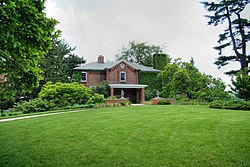
Michigan State University is a public land-grant research university in East Lansing, Michigan, United States. It was founded in 1855 as the Agricultural College of the State of Michigan, the first of its kind in the country. After the introduction of the Morrill Act in 1862, the state designated the college a land-grant institution in 1863, making it the first of the land-grant colleges in the United States. The college became coeducational in 1870. Today, Michigan State has facilities all across the state and over 634,000 alumni.

The Red Cedar River is a 51.1-mile-long (82.2 km) river in the U.S. state of Michigan. The river, which is a tributary of the Grand River in Michigan's Lower Peninsula, drains a watershed of approximately 461 square miles (1,190 km2) in the Lansing–East Lansing metropolitan area and suburban and rural areas to the east. The river flows through the campus of Michigan State University, and is considered a cultural symbol of the school, including being mentioned in the school's fight song.

Sparty is the mascot of Michigan State University. Sparty is usually depicted as a muscular male Spartan warrior/athlete dressed in stylized Greek costume. After changing the team name from "Aggies" to "Spartans" in 1925, various incarnations of a Spartan warrior with a prominent chin appeared at university events and in university literature. In 1943, MSU art professor Leonard D. Jungwirth designed a statue for the university, which had to be cast in terra cotta because of World War II rationing. In 2005, the university replaced Jungwirth's original statue with a bronze replica, moving the original indoors to protect it from the elements.
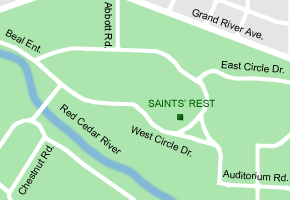
Saints' Rest was the second building erected on the campus of the Agricultural College of the State of Michigan. It was built in 1856 and served as the school's only dormitory until 1870, when Williams Hall was completed. Along with College Hall and a horse barn, it was one of three buildings completed when the college opened for classes in 1857.

College Hall was the first building erected on the campus of the Agricultural College of the State of Michigan, and the first in the United States to be erected "for the teaching of scientific agriculture." Reputedly designed by John C. Holmes, it was built in 1856 and housed the school's classrooms, offices and laboratories, the school's library/museum, and a multifunction lecture hall/chapel. Along with Saints' Rest, and a horse barn, it was one of three buildings completed when the college opened for classes in 1857.

The Beaumont Tower is a structure on the campus of Michigan State University, designed by the architectural firm of Donaldson and Meier and completed in 1928. The 104-foot-tall (32 m) tower marks the site of College Hall, the first building constructed on the campus, as well as the first building in America erected for instruction in scientific agriculture. Due to poor construction, College Hall collapsed in 1918. John W. Beaumont, an 1882 alumnus of MSU, proposed the construction of the monument to conserve the Campus Circle and serve as a monument to teaching.
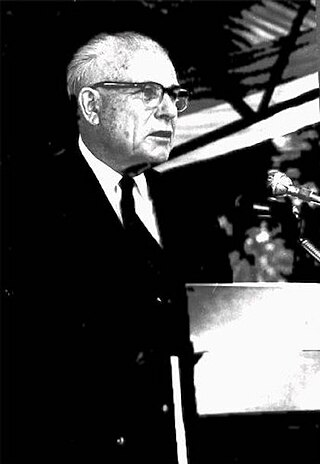
John Alfred Hannah was president of Michigan State College for 28 years (1941–1969), making him the longest serving of MSU's presidents. He is credited with transforming the school from a regional undergraduate college into a large national research institution. After his resignation from the university, Hannah became head of the United States Agency for International Development (USAID).
Laboratory Row is a collection of buildings at Michigan State University's campus in East Lansing, Michigan. Built in the late 19th and early 20th centuries it comprises the oldest collection of buildings on campus. The site originally was dedicated to the school's first farming facilities, but as the college outgrew its first buildings additional academic space was needed. In all, seven buildings were built, of which six survive today.

The Michigan State University Horticulture Gardens are horticultural gardens, with a landscape arboretum, located on Bogue Street on the Michigan State University campus in East Lansing, Michigan. The gardens are open to the public daily without charge.
The history of Michigan State University dates back to 1855, when the Michigan Legislature established the Agricultural College of the State of Michigan under the encouragement of the Michigan State Agricultural Society and the Michigan Farmer, the state's leading agricultural periodical. As the first agricultural college in the United States, the school served as a model for other institutions of its kind established in the period, to give an instance, the Agricultural College of Pennsylvania.

The campus of Michigan State University is located in East Lansing on the banks of the Red Cedar River, and comprises a contiguous area of 5,200 acres (21 km2), 2,000 acres (8.1 km2) of which are developed. Built amid virgin forest, the campus opened in 1855 with three buildings, none of which remain. As an agricultural college, the campus was originally located several miles outside of the city of Lansing, but as the population of the college grew, the city of East Lansing developed just north of the area's main avenue.

Demonstration Hall is a structure on the campus of Michigan State University. It was built in 1928 with offices, classrooms, and a riding arena for the Military Science department as a replacement for the Armory. Exhibitions of agricultural stock and implements were held here, as well as athletic events. It served as the home court for the Michigan State Spartans men's basketball team from 1930 to 1940, and the ice rink for the Michigan State Spartans men's ice hockey team from 1949 until Munn Ice Arena was completed in 1974.

Michigan State University Observatory is an astronomical observatory owned and operated by Michigan State University. It is located south of the Michigan State University campus in East Lansing, Michigan (USA), near the corner of Forest Rd and College Rd. It has a Cassegrain telescope in its single dome. Built by Boller and Chivens, the Michigan State University telescope was commissioned in 1969 and entered regular operation in 1970. In 1974, what was at the time a state-of-the-art Raytheon Microcomputer was installed to function as a data gathering and control system. Originally, single channel photoelectric photometry and photography using plates or film were the means of acquiring data. The observatory was closed from 1981 until 1986, at a time when the university was having financial difficulties. It was reopened in the spring of 1986 on the occasion of the return of Comet Halley and has been in regular operation ever since. Since the 1980s, a CCD camera has been employed as the main instrument and the Raytheon computer has been retired. The International Astronomical Union has assigned the MSU Observatory identification code 766.

William James Beal was an American botanist. He was a pioneer in the development of hybrid corn and the founder of the W. J. Beal Botanical Garden.

John Clough Holmes was an American agriculturalist, educator, and co-founder of the Michigan State Agricultural Society. Holmes is also known as the founder of Michigan State University, established in 1855 as an agriculture college, the first of its kind in the United States. Holmes Hall, the home of the Lyman Briggs College, is named in his honor.
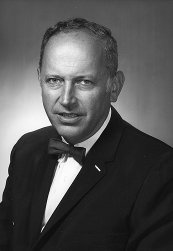
Walter Adams was an Austrian-born American economist and college professor. He served as the 13th President of Michigan State University and served as an expert witness before 36 congressional committees.
The Michigan State University Vietnam Advisory Group was a program of technical assistance provided to the government of South Vietnam as an effort in state-building by the US Department of State.
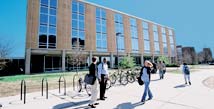
The Eugene C. Eppley Center is located on the Michigan State University campus in East Lansing, Michigan. It is home to a number of units within the Eli Broad College of Business, including the Department of Finance, the Full-Time Masters in Business Administration (MBA) Program offices, the MBA Career Services Center, the International Business Center (IBC)/Center for International Business Education and Research (CIBER), Multicultural Business Programs, the School of Hospitality Business, Undergraduate Academic Services, the financial analysis lab, the IBM On-Demand Supply Chain Laboratory, the Management Information Systems (MIS) Laboratory, the Team Effectiveness Teaching Laboratory, and the Lear Corporation Career Services Center.

Formerly known as Eustace Hall, Eustace-Cole Hall located on Laboratory Row is the only building on Michigan State University's main campus in East Lansing, Michigan that is on the National Register of Historic Places. Designed in a mix of "Queen Anne massing, Richardsonian Romanesque features, and Shingle Style", it was built in 1888 as the Horticultural Laboratory Building. Its design has been variously attributed to noted MSU alumnus and noted horticulturist Liberty Hyde Bailey and to Lansing architect William Appleyard It housed the horticulture department until 1924 when a new horticulture building was opened. It then became the University College Building until 1961 when it was renamed for Harry J. Eustace who chaired the Horticulture Department from 1908 to 1918.

Bowd–Munson Company was an architectural firm in Lansing, Michigan. The firm was a partnership between Edwyn A. Bowd and Orlie Munson.
